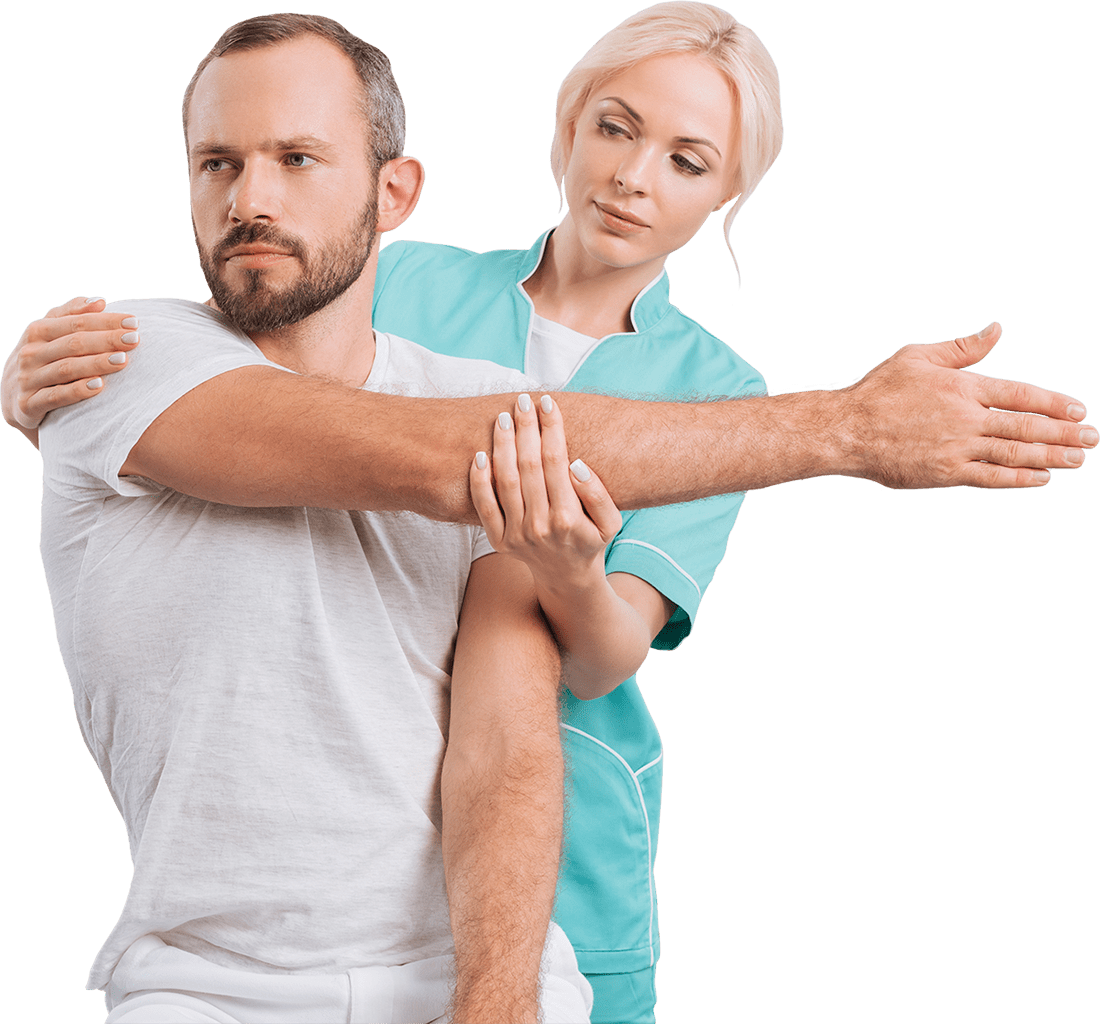Post-Operative Physiotherapy
Post-operative physiotherapy plays a specialized role in the recovery process for those individuals who have undergone surgery. A surgery may cause various problems like joint stiffness, decrease in joint range, muscle power, swelling and many more like circulatory or respiratory problems that may have developed in hospital stay.
Physiotherapy after surgery is very important and it starts immediately in the hospital. Once you get discharged from hospital, it’s important to start physiotherapy to achieve best recovery.
Role of a Physiotherapist in post-operative conditions
The role of a physiotherapist is essential in promoting recovery and overall health. He/she is the only person who can recover you after any surgery. Following are the roles of a Physiotherapist-
• Assessment and Evaluation
• Pain Management
• Mobility Improvement of joints
• Muscle strengthening
• Functional Independence
• Preventing Complications
Our team of Professional Physiotherapists, plan a comprehensive rehabilitation protocol for your recovery depending upon the type of surgery you had, and it can be in a clinic or in a gym environment or at your own home environment.
Recovery Phase after surgery
- Immediate or post anaesthetic phase
- Intermediate or encompassing the hospitalization period
- Convalescent phase
How we work
- We work closely with a large number of top Consultants and receive a high number of referrals for post-operative rehabilitation because we have the skills, experience and facilities to provide the best standard of care.
- We follow our protocol in which we thoroughly assess you and after detailed assessment of your power, range of motion of joint, flexibility or any other impairments, we plan a rehabilitation plan. The rehabilitation plan differs from person to person and case to case according to their needs and goals.
- Our aim is to provide advice and treatment on post-operative conditions like swelling, pain control and the specific exercises to make you capable of getting back to full fitness after your surgery. We will devise a comprehensive and tailored exercise program, for you & your stage of rehabilitation.
Benefits of physiotherapy after surgery
• Effective pain management
• Strengthening of weak muscles
• Stretching of stiff muscles
• Improve circulation and joint range
• Regain normal posture and independence
• Return to daily activities
Physiotherapy treatments can include
Pain and swelling: Pain is the main target after your surgery. Pain controls not only make you comfortable but speeds up your recovery. The incision made on your skin can cause a severe and crucial pain. Having some pain, bruising and swelling are normal parts of the recovery process following surgery. Applying cold packs or ice on the incision area helps in pain reduction. Swelling can be reduced by doing exercises or elevating your leg on a pillow in bed for several hours. Pain and swelling reduction makes the recovery smooth and comfortable.
Range of Motion: After surgeries ROM usually restricts a patient’s ADL. Starting ROM within 24 hrs. After surgery, prevent the adhesions .So, soon after the surgery the ROM exercises should be initiated to avoid local inflammation and swelling and for the better health and improvement of the patient. Once range is achieved, the pain definitely will go down.
Strength and flexibility: Strength exercises are activities that make your muscle stronger. It will increase your strength, size, power and endurance. Strengthening can be achieved by using your body weight or external weights. Flexibility is improving your joints and muscles to perform full joint movement. Flexibility can be achieved by stretching some tight muscles. These strength and flexibility exercises reduce chances of joint fusion and slow down the risks of bone and muscle loss.
Posture correction: Correcting your posture following surgeries is essential for your look as well as to prevent posture related pain, injuries or fatigue. A good posture will enhance your performance in your daily living activities. Doing some postural training will align your body, muscle balance, body mechanics and postural habits.
Balance and coordination: balance training is the ability to maintain line of gravity within the base of support. After surgeries, patients can achieve static balance on their own but dynamic balance can be achieved by using balance and coordination exercise. These exercises prevent chances of fall or injury, improve posture and enhance recovery.
Gait Training: The aim of gait training is to enhance mobility, stability and overall walking pattern. Depending upon the individual needs, walking aids such as canes, walkers or crutches may be introduced during gait training.
Patient Education: Educating the patient about the Do’s and Don’ts after the surgeries. Precaution plays a vital role in your recovery. Educating patients about the condition, time taken for the full recovery, doing proper exercises, decreasing the chances of inflammation or infection or weight or pressure application.

Common Post-Operative Conditions
- Abdominal Surgeries
- ACL Repair
- Amputations
- Balance and Coordination
- Brain Surgery
- C Section Surgeries (Caesarian)
- Cardiac Surgeries
- Collar Bone Fracture
- Congenital Deformities
- Fractures
- Gait Training
- Head Surgery
- Ligament Reconstruction
- Meniscal Repairs
- Muscle Reconstruction
- Natal Surgeries (Pre & Post)
- Neural Surgeries
- Pain Management
- Post-Operative Stiffness
- Pulmonary Surgeries
- Rehabilitations after Surgeries
- Rotator Cuff Injuries (RCI)
- Spine Surgeries
- Tendon Reconstruction
- THR (Total Hip Replacement)
- TKR (Total Knee Replacement)
Frequently Asked Questions
Post-operative physiotherapy is the assistance in recovery for those individuals who have undergone surgery. It helps the patients to achieve optimal health and normal life after the surgery.
Post-operative exercises are chosen by a physiotherapist according to the type of surgery and body part being treated. Different surgeries require different types of exercises. Like in Total Knee Replacement (TKR), the main exercises are-
• Ankle toe pump (ATM)
• Straight Leg Raise (SLR)
• Knee Flexion
• Knee Extension
• Hip Abduction
• Hip Adduction
• Prone straight leg raise (SLR)
• Quadriceps and Hamstrings Strengthening
• Stair Climbing
• Gait Training
Surgery is a tough process and it’s never been easy. It is a painful process and you need a good physiotherapist’s advice immediately after surgery. They will work to reduce your pain and speed up your recovery. Your surgeon will recommend getting physiotherapy from the best physiotherapy clinic because his surgery’s success is directly dependent on the physiotherapy.
Following are the benefits of rehabilitation:
• Effective pain management
• Strengthening of weak muscles
• Stretching of stiff muscles
• Improve circulation and joint range
• Regain normal posture and independence
• Return to daily activities
The primary reason for physiotherapy after surgery is to get back the mobility and return to daily activities. Pain and swelling management is the second most important reason. Physiotherapy will make you pain free and mobile.
The recovery after major surgery can be divided into 3 Phases:
- Immediate or post anaesthetic phase
- Intermediate or encompassing the hospitalization period
- Convalescent phase
Stage 1- Control pain and swelling
Stage 2- Improve range of motion and flexibility
Stage 3- Improve strength and balance
Stage 4- Sports-specific training
The rehabilitation process is different for different types of surgery. The main goal of rehabilitation is to reduce pain and swelling in the first phase. Then improving muscle power, flexibility and joint range and finally returning to sports or your daily activities. Depending upon the surgery you had, the rehabilitation process may take from a few weeks to a few months.
Physiotherapy starts immediately after your surgery and the aim is to postoperative complications. Physiotherapy services provided after surgery may be exercises, joint range of motion, breathing or gait training.
If you are not opting physiotherapy after surgery, a patient might never regain full range of a joint, may feel pain, can experience postural issues or his/her daily activities may be disturbed.
What our client says!

I recently visited here for physiotherapy, and I had a great experience. The staff were professional and knowledgeable, ensuring that I understood my treatment plan and exercises. The clinic was clean and well-organized, creating a welcoming environment.

I recently had a physiotherapy session at "YesPhysio Physiotherapy & Sports Rehab Clinic", and it was an excellent experience. The staff were friendly and knowledgeable, making me feel comfortable and well-cared for. The treatment was effective, and I felt much better and more relaxed after just one session. Highly recommend!

Staff having sound knowledge related to physiotherapy, staff is skilled and cooperative and hardworking. Clinic is having updated equipment and equipped with all necessary accessories which need during physiotherapy. My personal experience was good and I do recommend to all.

One of the best physiotherapists in Zirakpur, Balkar Ji is knowledgeable and treated my wrist and knee pain with advanced skills. Highly recommended

I had a tear in rotator cuff and balkar sir helped in my rehab, he was great with his work and the environment is very comfortable , I really recommend it. Great work.

Best physio clinic in town, Doctor balkar treated my tennis elbow, rotator cuff and lower back bulge. Highly recommended

According to me it is the Best Physiotherapy Clinic in Zirakpur and for the needful person they provide Physiotherapy at Home also.

They are giving great service among the people and i must they are very humble and well trained staff

